Mahlon Blaine - The Eyes Have It, 1955
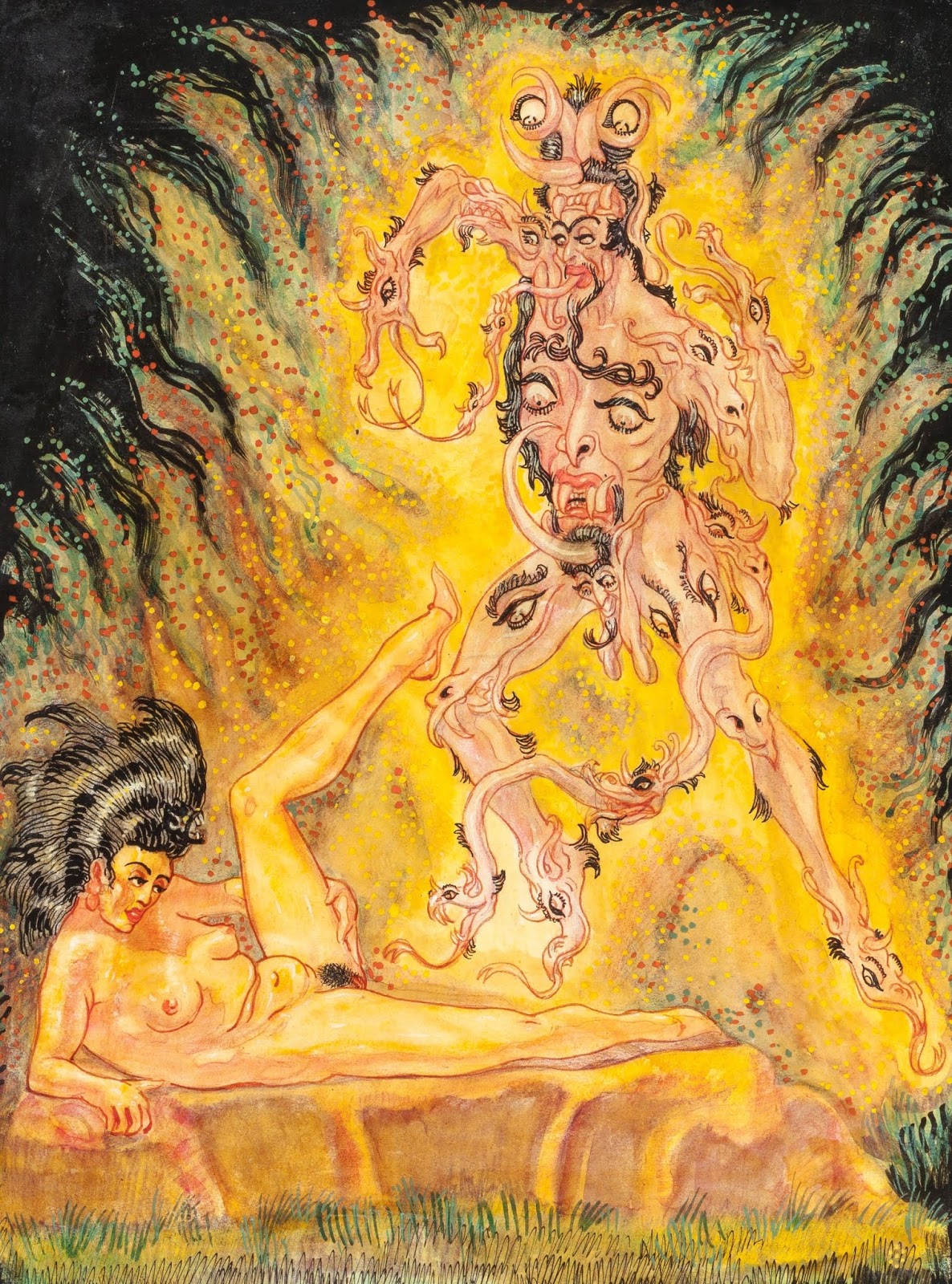 - source
- source Original Roleplaying Concepts
 - source
- source 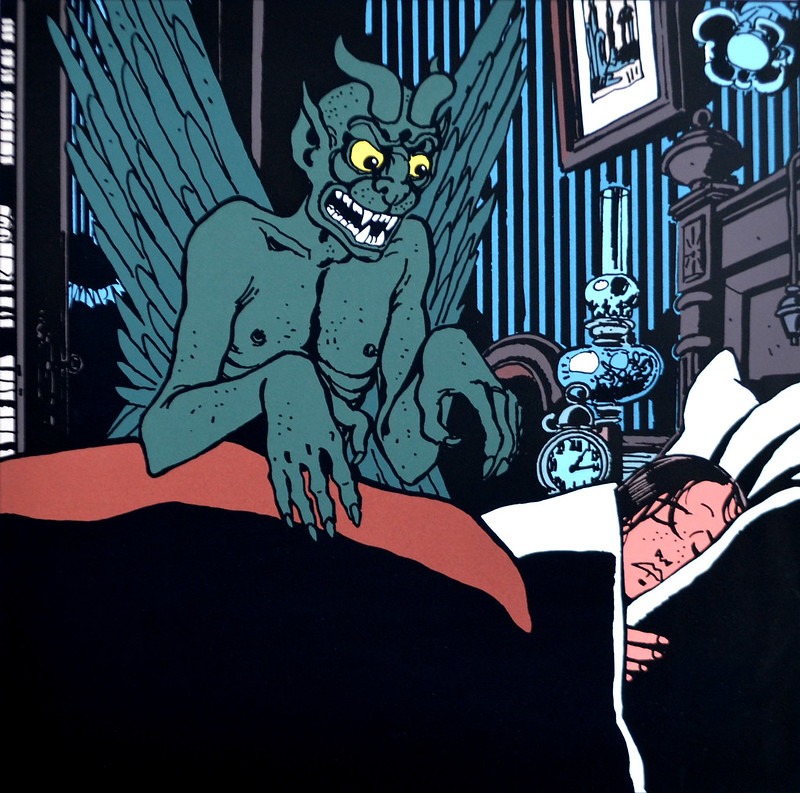 - source
- source 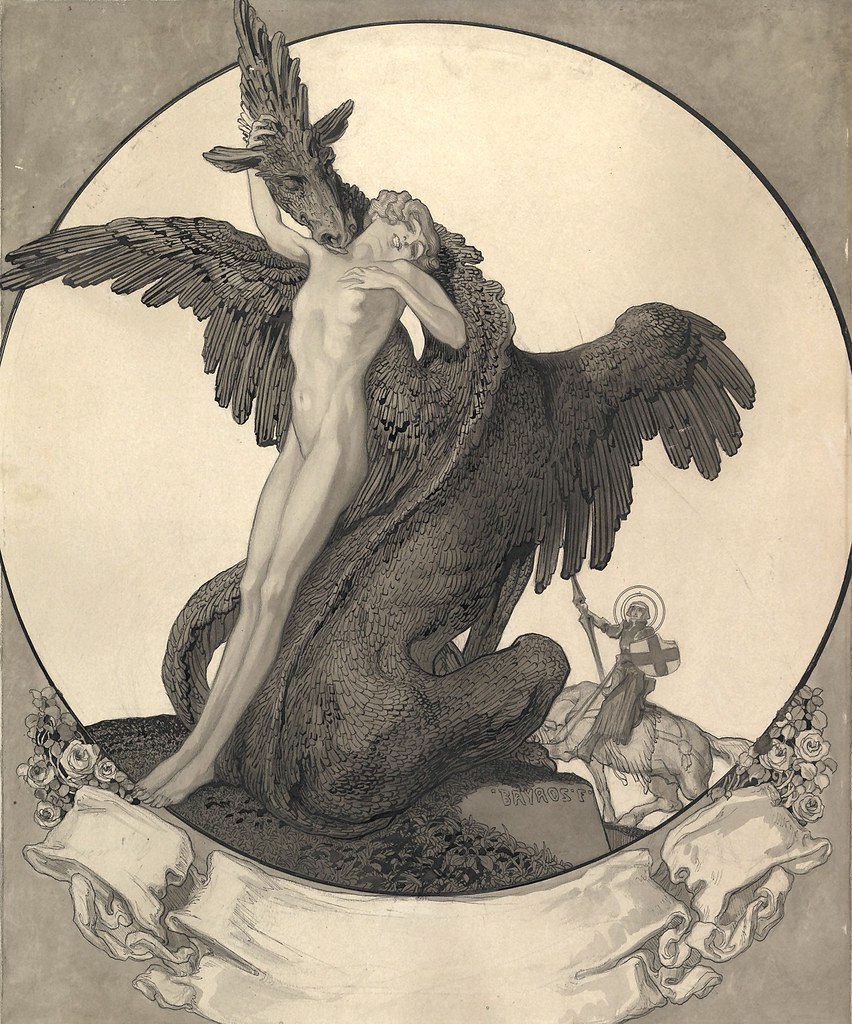 St George Rescuing a Maiden from a Dragon (Study for a Bookplate)
St George Rescuing a Maiden from a Dragon (Study for a Bookplate)
 Illustration for Dante Alighieri's 'The Divine Comedy'1921
Illustration for Dante Alighieri's 'The Divine Comedy'1921
 Illustration for Dante Alighieri's 'The Divine Comedy'1921
Illustration for Dante Alighieri's 'The Divine Comedy'1921
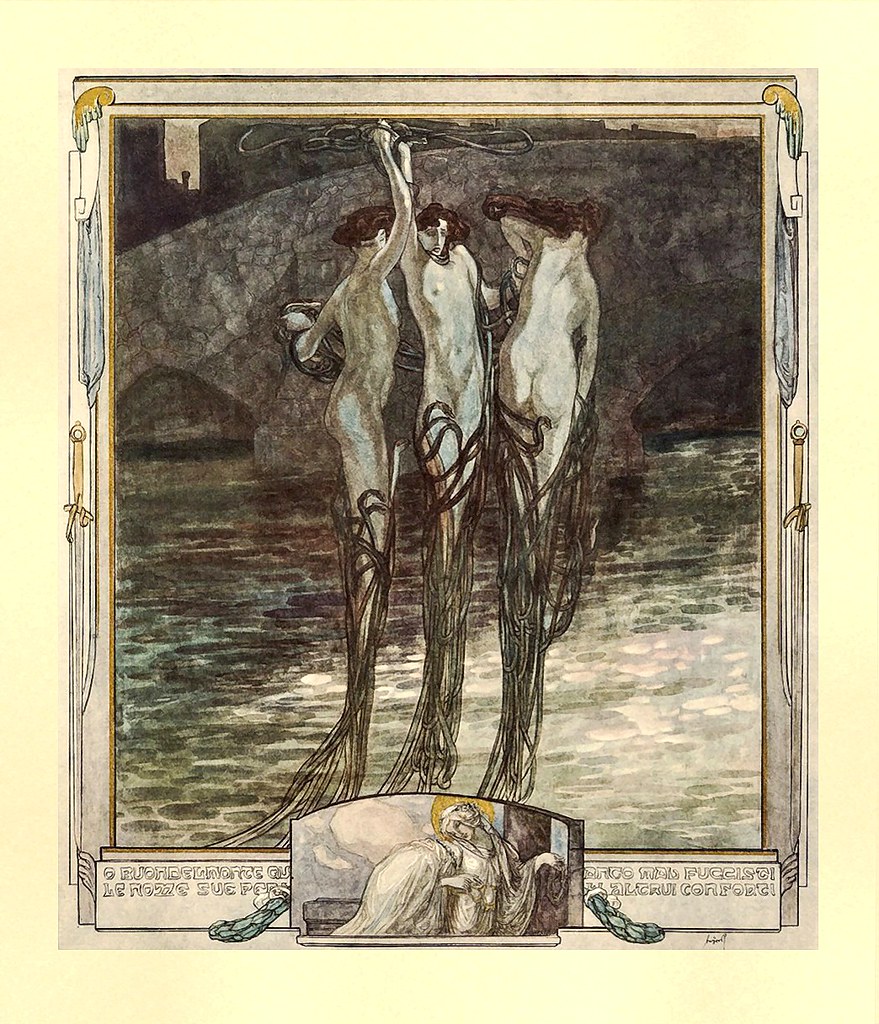 Illustration for Dante Alighieri's 'The Divine Comedy'1921
Illustration for Dante Alighieri's 'The Divine Comedy'1921
I stumbled onto this book years ago at a used book store. This collection of Bayros's erotic drawings "The amorous drawings of the Marquis von Bayros" is now available on archive.org, check it out here.
Much like the Miskatonic Repository for Call of Cthulhu, Seventh Edition, the Jonstown Compendium is a curated platform for user-made content, but for material set in Greg Stafford’s mythic universe of Glorantha. It enables creators to sell their own original content for RuneQuest: Roleplaying in Glorantha, 13th Age Glorantha, and HeroQuest Glorantha (Questworlds). This can include original scenarios, background material, cults, mythology, details of NPCs and monsters, and so on, but none of this content should be considered to be ‘canon’, but rather fall under ‘Your Glorantha Will Vary’. This means that there is still scope for the authors to create interesting and useful content that others can bring to their Glorantha-set campaigns.
—oOo— What is it?
What is it?Who do you play?
Player Characters of all types could play this scenario, but is best suited to members of a nearby Colymar tribe or Ducks. Humakti will, of course, relish the opportunity to curb the influence of Delecti the Necromancer.
 A decade ago, on January 12th, a plague struck the world. A flu-like plague which seemed resistant to the then available treatments. Fortunately nobody died, but eleven days later, on January 23rd, all of the symptoms vanished and everyone recovered. Only later did people realise the significance of what became known as ‘Ghost Flu’ as months later, sufferers began exhibiting powers and abilities only found in mankind’s wildest imaginings and biggest cinema screen franchise. The ability to fly, phase through walls, read the minds of others, control gravity, flatten or enhance the emotions of others, and read or even enter dreams. Literally, people had superpowers. This manifestation becomes known as the ‘Sudden Mutation Event’ or ‘SME’, and in the next ten years approximately one percent of the population will manifest SME. In response, there was no rash of costumed heroes or villains, though a few tried. The most photogenic of SME suffers became celebrities, sportsmen, television and film stars, or politicians, others found jobs related to their newly gained powers, for example, a firefighter who control flames or oxygen, a transmuter who could literally turn lead into (industrial) gold, or a healer who work as a medic or doctor, and the most popular sports found ways of incorporating them into their play. Some though turned to crime, and of course, there were criminals who exhibited SME, and whilst the Heightened as they became known were mostly assimilated into society, they could still be victims of crime and they were also victims of a prejudice all their very own. For example, the Neutral Parity League campaigns against ‘Chromes’ (from ‘Chromosome’) as the Heightened are nicknamed, often violently, whilst organisations like the Heightened Information Alliance campaigns for the protection of their rights. In general, the Heightened have become one of society’s accepted minorities and most just get on with their lives.
A decade ago, on January 12th, a plague struck the world. A flu-like plague which seemed resistant to the then available treatments. Fortunately nobody died, but eleven days later, on January 23rd, all of the symptoms vanished and everyone recovered. Only later did people realise the significance of what became known as ‘Ghost Flu’ as months later, sufferers began exhibiting powers and abilities only found in mankind’s wildest imaginings and biggest cinema screen franchise. The ability to fly, phase through walls, read the minds of others, control gravity, flatten or enhance the emotions of others, and read or even enter dreams. Literally, people had superpowers. This manifestation becomes known as the ‘Sudden Mutation Event’ or ‘SME’, and in the next ten years approximately one percent of the population will manifest SME. In response, there was no rash of costumed heroes or villains, though a few tried. The most photogenic of SME suffers became celebrities, sportsmen, television and film stars, or politicians, others found jobs related to their newly gained powers, for example, a firefighter who control flames or oxygen, a transmuter who could literally turn lead into (industrial) gold, or a healer who work as a medic or doctor, and the most popular sports found ways of incorporating them into their play. Some though turned to crime, and of course, there were criminals who exhibited SME, and whilst the Heightened as they became known were mostly assimilated into society, they could still be victims of crime and they were also victims of a prejudice all their very own. For example, the Neutral Parity League campaigns against ‘Chromes’ (from ‘Chromosome’) as the Heightened are nicknamed, often violently, whilst organisations like the Heightened Information Alliance campaigns for the protection of their rights. In general, the Heightened have become one of society’s accepted minorities and most just get on with their lives. Warlock! Kingdom is a supplement for Warlock!, “A Game Inspired By The Early Days Of British Tabletop Gaming”, in particular, Warhammer Fantasy Roleplay and Maelstrom as well as the Fighting Fantasy solo adventure books which began with The Warlock of Firetop Mountain. It has Careers—Careers such as Agitator, Boatman, Grave Robber, and Rat Catcher; it has two attributes, one of which is Luck; and it has a Warlock! running around an unnamed, humancentric kingdom causing mayhem. Although mechanically much lighter than Warhammer Fantasy Roleplay, it is nevertheless intended to be grim and gritty, a world of adventure and peril, but with mud aplenty—or worse—underfoot and a certain, sardonic sense of humour. However, beyond there being a marauding Warlock!, and gods, such as the beloved Thrice Blessed, the bloody Red King, and the reviled Dragon, there is unfortunately very little in terms of background in Warlock!. This is an omission that Warlock! Kingdom aims to rectify.
Warlock! Kingdom is a supplement for Warlock!, “A Game Inspired By The Early Days Of British Tabletop Gaming”, in particular, Warhammer Fantasy Roleplay and Maelstrom as well as the Fighting Fantasy solo adventure books which began with The Warlock of Firetop Mountain. It has Careers—Careers such as Agitator, Boatman, Grave Robber, and Rat Catcher; it has two attributes, one of which is Luck; and it has a Warlock! running around an unnamed, humancentric kingdom causing mayhem. Although mechanically much lighter than Warhammer Fantasy Roleplay, it is nevertheless intended to be grim and gritty, a world of adventure and peril, but with mud aplenty—or worse—underfoot and a certain, sardonic sense of humour. However, beyond there being a marauding Warlock!, and gods, such as the beloved Thrice Blessed, the bloody Red King, and the reviled Dragon, there is unfortunately very little in terms of background in Warlock!. This is an omission that Warlock! Kingdom aims to rectify. In ages past the greatest of all dungeons fell. Its great portals were penetrated by mighty heroes and level by level, its halls and corridors walked down, and its rooms and chambers, chapels and necropolises, lairs and dens, and reliquaries and treasuries entered, their denizens put to the sword and the spell, their coins, gems, and magics plundered. A millennium has passed since then and the doings of those great warriors and wizards have passed into legend and dungeons are things of the past, so perhaps it is time for a new network of tunnels and rooms, constructed and populated at the hands of a new Dungeon Keeper? Or at least the old Dungeon Keeper of old, woken after a thousand year slumber to build a dungeon anew?
In ages past the greatest of all dungeons fell. Its great portals were penetrated by mighty heroes and level by level, its halls and corridors walked down, and its rooms and chambers, chapels and necropolises, lairs and dens, and reliquaries and treasuries entered, their denizens put to the sword and the spell, their coins, gems, and magics plundered. A millennium has passed since then and the doings of those great warriors and wizards have passed into legend and dungeons are things of the past, so perhaps it is time for a new network of tunnels and rooms, constructed and populated at the hands of a new Dungeon Keeper? Or at least the old Dungeon Keeper of old, woken after a thousand year slumber to build a dungeon anew? One of the pleasures of visiting the home of a friend or acquaintance, is the opportunity to peruse his shelf. Does he have the same titles as you, suggesting that you share interests and friendship in common? If so, does he possess titles you have never seen before, perhaps books you want to read or simply never heard of? Or do his shelves hold titles on subjects you have no interest at all, revealing a point of divergence? Perhaps he will allow you to browse their contents or even take them home with you to read them at your leisure? Author Edward Brooke-Hitching is highly unlikely to allow you to do either. He barely mentions the titles he has in his own collection, let alone on his shelves, but in the pages of The Madman’s Library: The Strangest Books, Manuscripts, and Other Literary Curiosities From History, he explores the weird world of books that are mad, bad, and dangerous to handle (and even eat!), and which he would like to have in his library.
One of the pleasures of visiting the home of a friend or acquaintance, is the opportunity to peruse his shelf. Does he have the same titles as you, suggesting that you share interests and friendship in common? If so, does he possess titles you have never seen before, perhaps books you want to read or simply never heard of? Or do his shelves hold titles on subjects you have no interest at all, revealing a point of divergence? Perhaps he will allow you to browse their contents or even take them home with you to read them at your leisure? Author Edward Brooke-Hitching is highly unlikely to allow you to do either. He barely mentions the titles he has in his own collection, let alone on his shelves, but in the pages of The Madman’s Library: The Strangest Books, Manuscripts, and Other Literary Curiosities From History, he explores the weird world of books that are mad, bad, and dangerous to handle (and even eat!), and which he would like to have in his library. I started watching 1988's The Unnamable tonight thinking for sure I had seen it. Started it, couldn't remember it, then realized I had seen it.
I started watching 1988's The Unnamable tonight thinking for sure I had seen it. Started it, couldn't remember it, then realized I had seen it.The Unnamable (1988)
So there must be an unwritten rule that all modern adaptations of H.P. Lovecraft must take place in or around Miskatonic University and/or Arkham. After all, it makes good sense and if I were a filmmaker it is what I would do as well. Of course, it doesn't mean you always have to do it.
Case in point there is almost more about M.U. here than there is about the titular monster/character here. We get glimpses into the undergraduate life, the student body (and bodies), even people majoring in things other than medicine and the dark arts. But all of this is just fluff for the main story. Again a common problem, how to make a full-length movie out of a short story.
This one features Lovecraft's reoccurring protagonist Randolph Carter (this time played by Mark Kinsey Stephenson).
It is typical late 80s fare. Lots of gore. Lots of implied sexual antics.
In this second viewing (or third, who knows) I can help but think Randolph Carter here is kind of a jerk. By the time he comes around to helping anyone half the cast is dead. Yeah, it's a horror flick people are going to die, but his laissez-faire attitude borders on sociopathic negligence rather than a cool distance.
I wanted to also watch The Unnamable II but I can't find it anywhere. This is also a problem I am having with other Lovecraft-based flicks.

October 2021
Viewed: 11
First Time Views: 4.5
Alex Adams / October 6, 2021
In Toho’s 1965 tokusatsu spectacular Invasion of the Astro Monster, humanity makes contact with ruthless hive-mind aliens from Planet X, a new stellar body discovered on the far side of Jupiter. The aliens who inhabit this cold, bleak planet—the Xiliens—are a technologically advanced but blankly unemotional civilization, a race of grey-clad scientists whose remarkable intellectual development has allowed them to live safely underground in the hostile, unwelcoming environment of Planet X. They propose an interplanetary trade: if the world’s authorities—Japan, the US, and the UN—will lend them Godzilla and the fire-hawk Rodan in order to fight off the murderous three-headed space dragon King Ghidorah, who has, of late, become the scourge of Planet X, the Xiliens will provide humanity with the cure for cancer. This trade sounds like a win-win, a blessing, as Earth will simultaneously be rid of its two most troublesome inhabitants and gain a medical miracle. But, of course, it is a cynical double-cross: by stealing Godzilla and Rodan, the Xiliens have captured Earth’s only defences against Ghidorah, who is in fact a living weapon under their control that they plan to use to colonize Earth. Though the “superior” race comes offering gifts, they in fact seek to subjugate and exploit.
Invasion of the Astro Monster is a potent blend of alien invasion, mind control, and interplanetary blackmail. This story, retold several times in the Shōwa era of the Godzilla franchise, is a clear engagement with themes of anti-imperialism and anti-colonialism that were very much current across the globe in the mid-1960s, a decade featuring a panoply of gruesome colonial wars the world over in Algeria, Vietnam, Angola, Kenya, and elsewhere. It is widely acknowledged that Godzilla is, as Ian Buruma writes in the BFI DVD booklet for Ishiro Honda’s original Godzilla (1954), “a profoundly political monster.” But Godzilla’s many sequels are often written off as cheap and goofy cash-ins. Big mistake. Much as US sci-fi movies like The Blob (1958), The Thing From Another World (1951) or Invasion of the Body Snatchers (1956) used alien encounters to think through themes of cross-cultural contact, colonialism, and communism, the Shōwa Ghidorah movies are a rich engagement with world-historical themes of Cold War antagonism, first contact, and imperial manipulation.
A History of the DragonGodzilla has long been understood as a powerful symbol of nuclear devastation and the horror of war. While this is true, Godzilla has taken many forms over his seventy-year career, and he has symbolized a great many things. Philip Brophy writes that Godzilla is “less a vessel for consistent authorial and thematic meaning as he is a shell to be used for the generation of potential and variable meanings.” This is true of many of his adversaries too. Monsters have always been tremendously flexible and evocative ways of digesting ideas, fears, and emotions, and Toho’s Kaiju are no exception.
King Ghidorah, an enormous three-headed golden dragon inspired by Yamata No Orochi—a fearsome eight-headed dragon from Shinto mythology—is perhaps Godzilla’s most frequently battled adversary. Along with Mechagodzilla, Rodan, Mothra, and Godzilla, King Ghidorah is one of the cornerstones of the Kaiju Big Five, and his antagonism with Godzilla headlines eight movies, with further variations on Ghidorah also appearing in Godzilla: Final Wars (2004) and the Heisei Mothra trilogy (1996-1998). In the Shōwa period (1954-1975), he is a villain in Ghidorah, The Three-Headed Monster (1964), its sequel Invasion of the Astro Monster, the blockbuster monster brawl Destroy All Monsters (1968), and, as a supporting character, in Godzilla vs. Gigan (1972). In the Heisei period (1984-1995), Godzilla vs. King Ghidorah (1991) would see Ghidorah inflicted on Japan by time-travelling saboteurs—not to mention his cyborgic resurrection as Mecha-King-Ghidorah at the film’s climax. Ten years later, Ghidorah’s role was reversed when he teamed up with Mothra and Baragon to save humanity from Godzilla in Shusuke Kaneko’s Godzilla, Mothra, King Ghidorah: Giant Monsters All-Out Attack (2001). Later in the twenty-first century, King Ghidorah once again features as Godzilla’s arch-nemesis in The Planet Eater (2018), the climactic movie of the Polygon Anime trilogy, and King of the Monsters (2019), the second movie in the ongoing Legendary MonsterVerse. No other monster confronts Godzilla so many times and in so many forms. His Cold War appearances are, thematically, particularly rich and rewarding.
King Ghidorah’s first movie, Ghidorah: The Three-Headed Monster, is a crossover sequel that, through its incorporation of other successful Toho monsters into the Godzilla franchise, was the Avengers: Endgame (2019) of its day. In Rodan (1957), aggressive mining operations awaken a species of enormous and destructive prehistoric birds, and in Mothra (1961) a scientific expedition to Infant Island incurs the wrath of a colossal and beautiful winged insect. Both of these monsters would return in Ghidorah, meshing together their continuities with Godzilla’s and building a wider fictional universe overflowing with Kaiju. Both Rodan and Mothra had a clear environmentalist emphasis, but Mothra is particularly explicit with its political themes. Through its characterization of the greasy capitalist Clark Nelson as an amoral and exploitative villain and its satire of the imperialist nation “Rolisica,” the movie comments on Japan’s geopolitical conundrum: caught between the two nuclear superpowers, striving for more independence from American influence, and balancing the demands of economic prosperity and modernization with the desire to preserve traditional Japanese values. After the runaway success of King Kong Vs. Godzilla (1962/3), which fused monster spectacle with a satire of the advertising industry, Rodan and Mothra too would have their opportunity to confront Godzilla, enriching the franchise with political commentary.
The central themes of power and violence are developed iteratively through the Shōwa monster movies, from the nuclear allegory of Godzilla, the environmental anti-imperialism of the two Mothra films, and on into the Ghidorah movies, which comment much more explicitly on imperial violence and conquest. Mothra’s first sequel, Mothra vs. Godzilla (retitled in the US as Godzilla vs. The Thing) was released early in 1964, and later that year Ghidorah, the Three-Headed Monster hit cinema screens as a winter blockbuster. The movie’s bombastic plot saw the virtuous Mothra persuade the quarrelsome Rodan and Godzilla to team up against the alien peril Ghidorah, a beast more threatening and dangerous than anything anyone had seen before.
Perhaps the single most notable aspect of Ghidorah: The Three-Headed Monster is its lighter, more family-friendly tone. Where once they represented different flavors of doom, Rodan, Mothra, and Godzilla now come to humanity’s aid and are openly celebrated as the triumphant heroes of the hour. This broader tonal appeal has sometimes been read as a disengagement from political themes, as the movie’s crowd-pleasing entertainment value is seen as overriding any attempt to sermonize on social or political matters. Noted Godzilla investigator Steve Ryfle, for instance, writes that in this movie “high-brow issues like nuclear weapons and commercialism are abandoned in favor of pure, fast-paced escapism.” But the central antagonism in the film—the clash between the alien Ghidorah and the trio of cooperating Earthly Kaiju—in fact extends the series’ engagement with international politics even more boldly than the previous entries in the Godzilla series.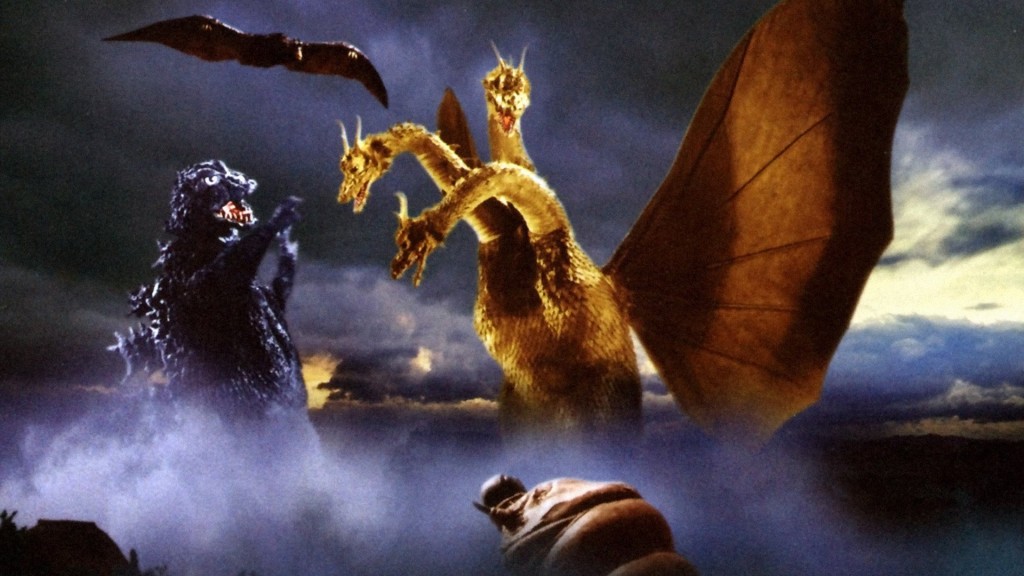
In a short tongue-in-cheek article in a 2000 issue of the Bulletin of the Atomic Scientists, Janne Nolan writes that Ghidorah’s first movie works as a compelling example of the benefits of international security cooperation. The movie “is a clear demonstration that even mutants, despite tiny brains and a Darwinian environment, can understand the imperatives of cooperative security when survival is at stake. Maybe policy-makers will be next.” Though Nolan is writing playfully here, this interpretation in fact has much to recommend it. Japan’s post-1945 constitution was written by the occupying US forces, and it placed firm restrictions on Japan’s ability to form an army of any kind. Over the following decades, this constitution and various additional security treaties that were added to it became increasingly controversial and unpopular across the political spectrum, culminating in violent protests in 1960. And there was plenty more happening abroad: China’s regional influence and nuclear weapons program were growing, and China tested its first atomic weapon two months before Ghidorah was released; the USSR was a strong and expanding regional presence; memory of the Korean War was painfully fresh; war raged, bloody and bitter, in Vietnam. Cooperative security, then (however reluctant and fragile), would be a theme that was at the forefront of many Japanese audience members’ minds in 1964.
As we have seen, the sequel Invasion of the Astro Monster (originally titled Godzilla vs. Monster Zero) followed in 1965, omitting Mothra and sophisticating the narrative. Where in his first appearance Ghidorah’s arrival on Earth had been a freak accident, in his second Ghidorah is cynically used against the Earth as part of an overtly imperialist venture by the Xiliens. Similarly, in Destroy All Monsters the Kilaak aliens hijack Earth’s monsters and unleash Ghidorah with the explicit aim of blackmailing humanity into submission. The Kilaaks announce that they come offering peace terms that humanity must accept or die; sacrifices must be made if the Kilaaks are to build the perfect world.
This rhetoric of peace is a particularly evocative element of the films’ representation of imperialism. Roman historian Tacitus famously wrote in Agricola, his history of the Roman conquest of Britain, that the Romans “make a desert and call it peace.” These words are spoken by Calgacus, a Caledonian war leader and resister of Agricola’s conquest, a “barbarian” Briton who Tacitus turns into an eloquent critic of the violence of the Roman Empire. Calgacus’s insight is that the bloodthirsty and warlike Romans, who conquer the entire world through slaughter, slavery, and pillage, cynically describe themselves as benevolent peace-bringers. Indeed, little has changed in the vocabulary of warlike empires: to this day, devastating imperial wars are justified as liberatory and civilizing, as the necessary violence that will bring enlightenment to the dark places of the world. Toho’s Astro-colonizers, too, repeatedly speak the language of peace and cooperation while preparing to annihilate or enslave humanity. In 1972’s Godzilla vs. Gigan (originally titled Earth Destruction Directive), Ghidorah is sidekick to the sinister robotic space-chicken Gigan, and once again both monsters are used against the Earth by an invading force of alien beings, this time the Nebula M aliens. In this one, huge cockroaches masquerading as humans are “striving to bring absolute peace to the whole world.” By this, the Nebula M aliens actually mean that they are plotting the eradication of humanity and the extractive exploitation of Earth’s environment and resources.
“Oh Glenn, I am governed by electronics”This masquerade, in which alien cockroaches appear indistinguishable from ordinary humans, is an interesting thematic overlap with a particularly politically charged Cold War form: the espionage thriller. It is of course no coincidence that the monster stories in Ghidorah movies are often complemented by espionage stories involving the human characters. This was due both to the explosive popularity of 007—Sean Connery had swaggered and snogged his way through Dr. No in 1962 and From Russia With Love in 1963, initiating a global sensation still going strong in 2021—and the rise of Japanese Yakuza crime films that were beloved by audiences. Importantly, many generic elements of Japanese crime and espionage stories (and their Western counterparts) translated particularly well to science fiction, including mind control, subterfuge, infiltration, and double-cross.
Some of the movies’ women are particularly important elements of the Cold War politics of the Shōwa Ghidorah stories. In Invasion of the Astro Monster, American astronaut Glenn’s (Nick Adams) Japanese fiancé Namikawa (Kumi Mizuno) is revealed to be in fact a Citizen of Planet X, where all women look identical—she has been sent by the ashen-faced Commander to seduce and surveil Glenn with the aim of recruiting him to the Xilien cause. Like a sexual temptress from an Ian Fleming novel, she has used her feminine wiles to compromise and manipulate our wisecracking male hero. However, in a campy yet emotionally powerful scene, she defies her programming to declare her authentic love for him—for which crime she is vaporized by her superior. “Our actions are controlled by electronic computers, not by human emotions,” explains the Xilien who coldly murders Namikawa. “When that law is violated, the offender is eliminated.” Likewise, in Destroy All Monsters, Kyoko Manabe (Yukiko Kobayashi) has a small metal receiver implanted into her earrings, and, robotically, she follows the Kilaaks’ every broadcasted command, blithely sowing destruction wherever she goes.
Brainwashing was a major cause of political panic in the late 1950s and early 1960s. American POWs, horribly traumatized by their torture in communist re-education camps, were filmed falsely accusing themselves of war crimes, refusing repatriation, and regurgitating communist propaganda. This extreme ideological indoctrination was dehumanizing, depersonalizing, humiliating, and appeared particularly terrifying because it seemed to show that the human brain could be rewired or manipulated to the extent not only that the prior personality was eliminated but, worse, that the victim appeared either blissfully unaware of or sycophantically grateful for their transformation. Very soon, however, the focus of the political panic sharpened, shifting from the suffering of the captured Americans to the possibility that repatriated soldiers could be reprogrammed into secret assassins whilst appearing, from the outside, to be respectable and well-integrated citizens.
In Richard Condon’s 1959 novel The Manchurian Candidate (famously adapted by John Frankenheimer in 1962), for example, the stepson of a prominent anti-communist senator is brainwashed and used as a remote-control communist assassin. The double agent, unaware of his own programming, is memorably described as “Caesar’s son to be sent into Caesar’s chamber to kill Caesar.” Soon enough, of course, this would shift once more into a more generalized scaremongering about Soviet indoctrination, sleeper agents, and totalitarian mind control that clearly influenced Toho’s Ghidorah movies. The enemy who seems concerned for our safety but who secretly plots our violent demise—the double-crossing double agent, the indoctrinated infiltrator—was a very widespread Cold War bogeyman, and he remains with us today in the modified form of the secretive “lone wolf” terrorist living and moving among us.
“The standard message” of the science fiction film, writes Susan Sontag in 1966’s Against Interpretation, “is the one about the proper, or humane, use of science, versus the mad, obsessional use of science.” Later: “Science is magic, and man has always known that there is black magic as well as white.” The black magic of mind control is one of the most enduring aspects of Cold War political panic. In their attempts to “scientifically” understand Communist brainwashing, the CIA developed the MKUltra program, a set of gruesome torture sessions masquerading as scientific investigations into the limits of human endurance. This program (and the assumptions about the scientific possibility of directing the human mind that underpin it) has continued to have terrible ramifications into the present, as psychologists were brought in to develop the post-9/11 torture program, pseudoscientifically dignifying scandalous mistreatment by presenting it as a controlled and methodical process of scientific investigation. In each of these cases, black magic is not magic at all, but simply, and sadly, torture. Of course, it is overreach to suggest that the Shōwa Ghidorah movies are about CIA torture; but it is clearly true that brainwashing and mind control have always been deeply political concerns.
King Ghidorah: A Political DemonologyThe four Shōwa movies featuring Ghidorah are, then, remarkably thematically consistent. Alien invasion, subterfuge, mind control, and monster cooperation (a kind of Kaiju anti-imperialism) are central to each of them. Most fundamental, however, is the theme of power. Ghidorah is, after all, a King: a total sovereign, breathing fire, exercising absolute and arbitrary power over everything he surveys. It’s true that there is a lot of knockabout fun involved, but the Shōwa Ghidorah movies are also vibrant explorations of authoritarian power, of the political totalitarianism that was so powerful and such an omnipresent concern in the mid-20th century. Importantly, too, a major part of the appeal of the films is their ambiguity. It’s difficult, after all, to say exactly which empire Ghidorah’s villainous commanders are supposed to represent, and, in any case, pinning it down to one definite answer would only diminish the sloshy, sticky generosity of the metaphor.
But it is nonetheless interesting to think it through in terms of concrete possibilities. Since the relationship to the US was a matter of considerable controversy in 1960s Japan, the Astro-colonizers in these movies could well represent America—that most powerful and potentially violent of international actors, the occupier turned ally whose boot was slamming down heavily and noisily in Vietnam. The USSR was also a significant political concern, another expansionist superpower bearing down upon Japan; as we have seen, brainwashing was seen as a specifically communist tactic. But the Cold War period was also marked by precipitous decolonization and rapid, blood-soaked political reconfiguration. The French suffered humiliating and ruinous defeats in Indochina and the Maghreb, most notably in the Algerian Revolution, a bitterly violent conflict abroad that caused the downfall of the Fourth Republic at home. Britain fought dirtily in harrowing counterinsurgency wars in Kenya, Aden, Cyprus, Malaya, and elsewhere. Portugal, too, prosecuted a gruesome campaign in Angola that ended in ignominious defeat. Japan, of course, had its own share of Imperial shame.
Invasion of the Astro Monster makes explicit reference to this global unrest in a startling montage of documentary photography that follows the revelation of the Xilien betrayal.
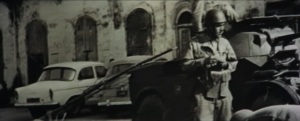
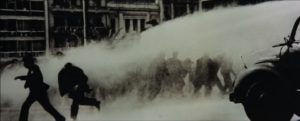
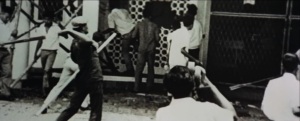

In the 1960s, cities the world over, including Tokyo, were the stages of protests, unrest, and heavily militarized police crackdowns as groups representing a wide array of new political forces rose up against the established order. This clear visual reference to the global reconfigurations of power that were taking place in the long wake of World War 2 unambiguously situates the Xilien conquest in the tradition of Earthly political upheaval. The Xiliens could be the French, the Soviets, the US, Perfidious Albion—the British Empire—or even the militaristic Japanese Empire of recent memory. Destroy All Monsters, too, set in the utopian future of 1999, shows the fragility of international peace and its vulnerability to imperialist aggression. The futuristic society at the end of the Millennium, dedicated to cooperation and scientific discovery, is still easy prey to the calmly, arrogantly seductive Kilaaks, who are an amalgam of every negative trait ascribed to imperialists: parasitic, violent, manipulative, and smugly convinced of their own superiority. In the final analysis, it is precisely the fact that the Kilaaks, Nebula M aliens, and Xiliens represent imperialism in general, rather than any specific historical constellation, that gives these movies their power.
This condemnation of empire, of course, raises an interesting contradiction, or tension, with relation to the US. One of the defining ideological contradictions of postwar America is that it has managed to present itself as somehow “not an empire” despite its constant projection of militarized power across the planet. The demonization of the tactics of the duplicitous aliens in Invasion of the Astro Monster—a Japan-US co-production—is, for example, clearly in harmony with the political ends of American Cold War neo-imperialist ideology, and serves to cement US-Japan relations as much as it does to criticize them. That is, by using the Xiliens to caricature the crimes of the dying 19th century empires and showing the countries of the democratic capitalist West as an anti-imperial coalition defeating the villains, US-led imperial aggression is painted as a form of humanistic anti-imperialism. The fetishization of anti-imperial resistance is, after all, a core component of contemporary imperial ideology: think Star Wars or any number of similar genre pieces in which plucky Davids smash brutish Goliaths.
In summary, then, the Shōwa Ghidorah films are extraordinary documents of Cold War politics. As they were being made, the old empires were being smashed to the ground, and in the process imperial power itself was problematized and condemned as never before. In this context of global transformation, imperialism itself took on the appearance of senseless, cruel, and openly manipulative barbarism, and imperialists were known more openly as blackmailers, villains, and torturers—or, as Glenn puts it in Invasion of the Astro Monster, as “double-crossin’ finks.” What better metaphor, then, for the arbitrary despotism of empire than a colossal golden hydra remotely controlled by forked-tongued extortionists?
![]() Alex Adams is a writer based in North East England. He writes widely on popular culture and politics, and he is currently writing Godzilla: A Critical Demonology for Headpress Books. Follow him on Twitter at @AlexAdams5 and @GDemonology, or visit his website to read more.
Alex Adams is a writer based in North East England. He writes widely on popular culture and politics, and he is currently writing Godzilla: A Critical Demonology for Headpress Books. Follow him on Twitter at @AlexAdams5 and @GDemonology, or visit his website to read more.
 Ok. I can already tell that a Lovecraft film-fest is going to be rough. Lovecraft's writings rarely translate well to the screen, this one is no exception.
Ok. I can already tell that a Lovecraft film-fest is going to be rough. Lovecraft's writings rarely translate well to the screen, this one is no exception.The Thing on the Doorstep (2014)
This one looks like it was a student film, except everyone looks too old to be a student.
The story sort of follows the Lovecraft short story, updated to modern times.
The cast is all unknowns. For most of them, this is their only film credit.
The filming has an odd sepia tone to it that I thought was more than a little annoying. It certainly gave it a solid straight-to-video vibe about it.
Again this video commits the worst sin a horror movie can; it was boring. I made it halfway through and ended up fast-forwarding to the end. I am sure I missed nothing. But given that I can only give myself half a point.

October 2021
Viewed: 10
First Time Views: 4.5
 "Son, she said, have I got a little story for you
"Son, she said, have I got a little story for youOh I, oh, I'm still alive
Hey, I, I, oh, I'm still alive
Hey I, oh, I'm still alive."
Pearl Jam, "Alive" (1991)
It's October. There's a chill in the air and there is a feeling in the air. Something that makes me reflective, chilly, and maybe a little melancholy. Sounds like the 90s to me. There is also a game that captures this feeling perfectly. Bloat Games' newest offering in the SURVIVE THIS!! series; We Die Young RPG.
I have been waiting to share this with you all and today is that day!
We Die Young RPG Core Rules
"Tell me do you think it would be alright If I could just crash here tonight?"
We Die Young RPG Core Rules is 372 pages with color covers and black and white interior art. The book is digest-sized, so the same size as Bloat Games other games. The game was Eric Bloat & Josh Palmer with art by Phil Stone and additional art by RUNEHAMMER & Diogo Nogueira.
For this review, I am considering the just-released PDF on DriveThruRPG that I got as a Kickstarter backer. The print book is due out soon.
Comparisons between this game and their first game, Dark Places & Demogorgons are natural and I think needed. I spent a lot of time with DP&D so I am looking forward to seeing how I can use this game with that as well. But first, let's get into the game proper.
The book begins with two dedications from the authors. I want to repeat them here since they set the tone not just for the game but also for my review.

Introduction
"With the lights out, it's less dangerous. Here we are now, entertain us."
Here we are introduced to the newest SURVIVE THIS!! game. The authors are upfront about their inspirations here; grunge music from the 90s and the games that were popular at the time. Having already gone through the book a few times it is a thread that weaved in overt and subtle ways, but it never feels overused, hackneyed, or clichéd. We are given some in-game background for why the Pacific Northwest is so full of supernatural strangeness and it is a fun explanation. But to quote the late, great Bard of Seatle I prefer it "always been and always be until the end." But it works well.
The basics of RPGs are covered and what you need to play. Next we get into character creation.
 Character Creation
Character Creation"I'll be whatever you want. The bong in this Reggae song."
Character creation follows the same process as other SURVIVE THIS!! games and by extension most Old-School games. We are told from the word go that we can add material we want from the other SURVIVE THIS!! games.
Attributes are covered which include the standard six, plus the "Survive" attribute common to all SURVIVE THIS!! games. My first thought? My Dark Places and Demogons characters have grown up and moved to Seatle.
Like the other games in this family, Hit Points start with a 2d6 and increase by 1d6 per level regardless of class or race. Combat can be quite deadly in these games for people used to the hardiness of even Old-School D&D characters.
Saving Throws are different from D&D but the same as DP&D with the edition of the Magic save. This does make porting over characters and ideas from the other games pretty easy.
Alignment covers Righteous, Law, Neutral, Anarchist, and Evil.
Races
"All I can say is that my life is pretty plain, You don't like my point of view and I'm insane."
Here we get into the really new material. We have a bunch of new races for this setting. These include shapeshifting Doppelgangers, undead Ghouls, garden variety Humans, the immortal Imperishables, the ancient undead Jari-Ka, the various Realm-Twisted Fey (my new favorite, and I am sure I dated a Twitter Fey back then), Vampires (sparkles are optional), and Were-beasts of all stripes. If you played ANY RPG in the 1990s you know what you are getting here, but still, they manage to make it feel both new and old at the same time. New, because there is new potential here and old because they feel comfortably familiar; like that old flannel in the back of your closet or those beat-up old Doc Martens.
The races are well covered and you could easily drop them into any other SURVIVE THIS!! game or even any other Old-School game. They are really quite fun and I could not help but think of what characters I wanted to make with each one. This covers about 40 pages.
This is followed by a list of occupations with their bonuses.
Classes
"This place is always such a mess. Sometimes I think I'd like to watch it burn."
 We Die Young is a class/level system. There 16 classes for this game. Some look like repeats from DP&D but are not really. They are updated to this setting and older characters. We are told that classes from the other SURVIVE THIS!! games are welcome here.
We Die Young is a class/level system. There 16 classes for this game. Some look like repeats from DP&D but are not really. They are updated to this setting and older characters. We are told that classes from the other SURVIVE THIS!! games are welcome here.Our classes include the Mystic (tattoos mages), Naturalists (potheads, I mean druids), Papal Pursuant (soldiers of God), Psions (Carrie), Revenant (Eric Draven the Crow), Riot Grrl (what it says on the tin), Rock Star, Serial Killer, Shaman (oh here are the potheads), Sickmen (homeless, as seen by Sound Garden), Street Bard, Street Fighters, Thralls (Vampire servants), Tremor Christs (psionically powered religious prophets), Warlock (steal power for otherworlds), and what I can only assume is an attempt to get a good review from me (just kidding!) the Witch.
The witch here is slightly different than the ones we find in DP&D. So there can be no end to the witchy goodness you can have by combining games.
That covers a healthy 50 pages.
Skills
The skill system for We Die Young is the same as DP&D. Though without checking it feels a bit expanded. You get points to put into skills and there are DCs to check. Very 3e. Or more like 3e IF it had been written in 1995. So, yeah, another solid point for this game.
Magic (& Psionics)
"Show me the power child, I'd like to say. That I'm down on my knees today."
Here is one of my favorite things in a game. There is a mythos added to the system here that is rather fun (see Spellcasters & Salt) as well as rules for Rune-Tattoos. Yeah, this is the 90s alright!
Now I have to say this. If adding a witch class is trying to get me to do a good review, then these spell names are outright flirting with me. Spells called "All Apologies", "Heaven Beside You", "Black Days", "Wargasm", "Super Unknown", and "Far Behind"? Yeah. That is hitting me where I live. And that is only the very tip of the iceberg.
Magic, Spells and Psionics cover a little over 60 pages and I feel they could have kept going.
Equipment
"What did you expect to find? Was there something you left behind?"
No old-school flavored game is complete without a list of equipment. This includes common items, weapons, and even magical items. Don't fret, it's not like there is a Magic Shop there. A "Health Locker" costs $50k and that is if you can find one.
The list of drugs is really interesting and fun. Look. It was the 90s. Everybody was taking drugs.
New to this setting are the Zapatral Stones. These are the remains of a meteorite that fell to Earth and hit the Pacific Northwest and Mount Rainer in particular. They have strange power and effects depending on the size of the stone and the color.
Playing the Game
"Whatsoever I've feared has come to life. Whatsoever I've fought off became my life."
Here we get our rules for playing the We Die Young game. We get an overview of game terms, which is nice really. New rules for Curses, Exorcisms, and Madness are covered. It looks like to me they could be backported to DP&D rather easily.
There is a fair number of combat rules. Likely this has come about from the authors' experiences with their other game Vigilante City.
We also get rules for XP & Leveling Up and Critical tables.
The World of We Die Young
"I'm the Man in the Box. Buried in my shit."
This is great stuff. This is the built-in campaign setting for We Die Young set place in a mythical and magical Pacific Northwest. the TL;DR? Grunge woke supernatural creatures. Ok, I can do that. I mean it is not all that different than ShadowRun right?
The setting of the PNW/Seatle on the 90s is covered well. I had many college friends that made the trek out to Seatle after our graduations (91 to 93 mostly), so I have some idea of what was happening on the ground level. Twenty-somethings like me seemed drawn to the place by some mystic siren song. A siren song with a Boss DS-2 distortion pedal.
Various associations/groups are covered, like Jari-Ka circles, Ghoul Legacies, Vampire Lineages, were-kin groups. Like I said, if you played RPGs in the 90s you know the drill. But again they are still both "new" and "old" at the same time. Kudos to the authors for giving me something new AND invoking nostalgia at the same time.
We also get some great locations of note and some adventure seeds which include some creatures.
Bestiary
"She eyes me like a Pisces when I am weak. I've been locked inside your heart-shaped box for weeks."
 This covers all the creatures you can run into. The stat blocks are similar enough to Basic-era D&D to be roughly compatible. They are 100% compatible with other SURVIVE THIS!! games, so the excellent DARK PLACES & DEMOGORGONS - The Cryptid Manual will work well with this. In fact, I highly recommend it for this.
This covers all the creatures you can run into. The stat blocks are similar enough to Basic-era D&D to be roughly compatible. They are 100% compatible with other SURVIVE THIS!! games, so the excellent DARK PLACES & DEMOGORGONS - The Cryptid Manual will work well with this. In fact, I highly recommend it for this. There is a good variety of creatures. Angels, Demons, BIGFOOT! and more.
We get about 47 pages or so of monsters with stat blocks and an additional 10 pages of templates to add to monsters such as "Vampire" and "Radioactive."
Radioactive Bigfoot. I don't need a plot. I have that!
We get Adventure Hooks next. Roll a d100 and go!
The Appendix includes some Grung songs to get you into the mood. Some Seattle Grunge bands, some not-Seatle Grunge Bands, and some late 80's and 90's Alternative bands.
There is a list of movies about the era. A list of books. And finally the index and OGL.
Thoughts
Wow. What a really damn fun game!
If Dark Places & Demogorgons gave a "Stranger Things" 80s, this gives me a strange supernatural 90s.
It is exactly what I would have expected from the fine folks at Bloat Games.
My ONLY question about this setting is "Where are the UFOs and Aliens?" I mean NOTHING was bigger in the 90s than "The X-Files." I get that it is hard to cleave 90s Aliens to 90s supernatural (ask anyone that has tried to play WitchCraft AND Conspiracy X), but maybe a supplement is due out later? I would suggest grabbing DARK PLACES & DEMOGORGONS - The UFO Investigator's Handbook to add some X-Files flavored goodness to We Die Young.
Back in the early 2000s I had a game I was running, Vacation in Vancouver. It took place in the 90s and in Vancouver (naturally). These rules make me want to revive that game and see where I could take it now.
The bottom line for me is that SURVIVE THIS!! We Die Young RPG is a great game. The pdf is fantastic and I can't wait for my Kickstarter books.